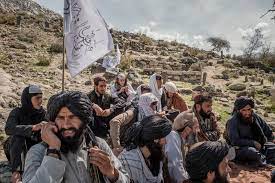Prof (Retd) Verinder Singh Manhas
The origin and history of Taliban goes back to the formation of Afghanistan as an ethnic mystery. The Mongoloid, Tartars, Uzbek, Tajiks and Pathans (Pashtoons, Pakhtoons) were the first to settle in the dry, barren lands of Northern and South Eastern Afghanistan making it a crossroads to travel in the medieval age. The modern age brought about a consolidation of ethnic tribes by Dost Mohammad in Islamic times. The industrial revolution brought the European Countries to Afghanistan suppressing the ethnic groups. The Uzbek, Tajiks and Turkmen became merchants while the Pashtoons remained as warlords in Southeast and South Afghanistan. The geostrategic importance tempted the Russians and the Imperialist British into Afghanistan which finally resulted into what popularly is known as the ‘Great Game’. Thereafter, the political structure post exile period of Dost Mohammad included two faction within The People’s Democratic Party, the Khalq having a communist inclination and the Parchams with capitalist school of thought. The Khalqies politically dominated the area North and the Northwest of the Hindu Kush Ranges while the Southern and South western parts were under the Parchams. The political turmoil during this period often led to assassination of important leaders such as Hafizullah Amin and Babrak Karmal. Two school of political thoughts brought an economic diversification and as a result of agrarian transformation primarily in the eastern and south western parts led to authority of the Pashtoons over other ethnic groups.
Afghanistan in the 1980s saw the invasion of USSR which lasted for approx 9 years. The ethnic tribes in an endeavor to evict the Soviets made a consolidated effort however the age-old difference within the groups still persisted. The geopolitical situation in USSR and persistent armed resistance of the Afgan people brought about a change in the Soviet foreign policy ultimately leading to withdrawal of forces post the ‘Afghan Accord’ singed on 1st Jun 1988 under the UN.
Taliban, Pashto/ Pashtun, also spelled Taleban from southern Afghan province of Kandahar, ultraconservative political and religious faction under the leadership of Mullah Omar and Mullah Mohammad Hassan Rehmani emerged in Afghanistan in the mid-1990s following the withdrawal of Soviet troops, the collapse of Afghanistan’s communist regimeand the subsequent breakdown in civil order. The faction largely consisted of members trained in madrasahs (Islamic religious schools) that had been established for Afghan refugees in the 1980s in northern Pakistan. By late 1996, support for the Taliban among southern Pashtun ethnic group, as well as assistance from conservative Islamic elements abroad, had enabled them to capture and control the country. However, non-Pashtun ethnic groups—namely, the Tajik, the Uzbek, and the Hazara—in the north, west, and central parts of the country continued their resistance against what they considered the extension of the Pashtun hegemony.
Taliban as on date remains unrecognized by the world as a country even after it came to power after bringing an end to almost 20 years of a US-led coalition’s presence in the country.
A Glossary of Pashtoon Tribes
* Abdalis Known as Durrani since 1747-located in southern Afghanistan centred around Kandhar sub-tribes-Barvkzai, Achakzai, Poputzai, Alikozai, Narzai, Jshaqzai, Alizai, etc.
*Afridis Sub-tribes-Adamkhel, Akakhel, Kanwar Khel, Kambar Khel, Zakka Khel etc. – sedentary agriculturists and vertical nomads-most of them live east of the Durand line.
*Babars Located near Dera-Ismail Khan-mostly landlords with non-Pashtoon tenents.
* Banis A small tribe located near Quetta.
*Bangash Sub-tribes-Mirenzai, Samilzai and Baizai. They line south of Peshawar in the Kohat valley. Agriculturists and Shia by religion.
*Barech Inhabit Sherewak district of Afghanistan, while same live in Baluchastain.* Dandzais Sub-tribes-Mamer, Yusuf, Manki etc live north of Peshwar and south of the Kabul river.
* Dandzais Sub-tribes-Mamer, Yusuf, Manki etc live north of Peshawar and south of the Kabul river.
* Daurs Sedentry agriculturists in upper and lower Dawar Valley.
* Gharbines Inhabit Jurrem Valley-claim Arab ancestory.
* Ghilzai Sub-tribes-Hotaki, Tbkhi, Nasar, Andar, Alikhel, Tarekhi, Suleimankhel. Centre at Kattawaz. Many of them are “Kochis” or nomads.
* Jadrans Aggressive and warlike-inhabit southern part of khost in Afghanistan.
* Khugianis Agriculturist inhabiting southern Jalalabad.
* Mahsuds Sub-tribes-Alizai, Bahlalzai, Shamenkhel etc they inhabit the centre of Waziristan.
* Makbals Inhabit the centre war upper Kuran Valley.
* Mohamands Sub-tribes-tarakhzai, Halimzai, Khwaezai, live between the Kabul river and Bajaur.
* Mullagoris A small tribe north of Khyber Pass.
* Safis Two section-safis and Kendaharis. Inhabit the region between kuner and panjsheer river-priobably converted into Kajins.
* Shilmanis A small tribe living north and east of the Afghan town of Dakka.
* Shinwaris Inhabit Jalalabad valley, west of safed. Koh upto the Kabul river-well armed and powerful tribe four sections Marnehzai Sangukhel, Sipah am Ali Sherkhel.
* Turis Inhabit Kurrem valley, only Pashtoons who are entirely shia in religion.
* Urmers A small Pushto speaking group inhabiting logar valley veer Kabul.
Trending Now
E-Paper


